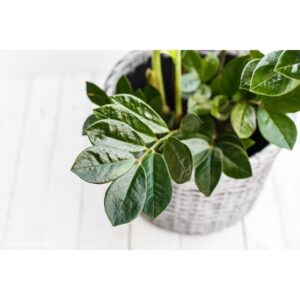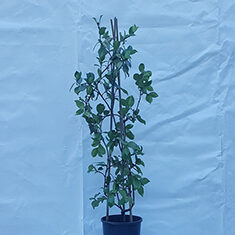Description
Hoyas are evergreen perennial creepers or vines or rarely, shrubs. They often grow epiphytically on trees; some grow terrestrially, or occasionally in rocky areas. They climb by twining, and with the employment of adventitious roots. Larger species grow 1–18 m, or more, with suitable support in trees. They have simple entire leaves, arranged in an opposite pattern, that are typically succulent. Leaves may exhibit a variety of forms, and may be smooth, felted or hairy; venation may be prominent or not, and many species have leaf surfaces flecked with irregular small silvery spots.
The flowers appear in axillary umbellate clusters at the tip of peduncles. Hoya peduncles are commonly referred to as spurs. In most species these spurs are perennial and are rarely shed. Each flowering cycle increases the length of the spur, and in the larger species can eventually reach 27 cm (11 in) or more. Flowers vary in size from 3 mm to over 95 mm in diameter. Flower form is typically star-shaped, with five thick, waxy, triangular petals, topped with another star-shaped structure, the corona. Colours on most species range from white to pink; there are species that exhibit yellow to orange, dark reds to near-black, and there are green flowers. Many are sweetly scented. and most produce abundant nectar.
Pollinators include moths, flies, and ants. Pollination is poorly understood, but plants left outdoors in temperate regions do sometimes produce seed, indicating pollination by local insects.
Seeds are borne in twin pods, actually follicles, are generally light, and are dispersed by the wind by means of a small tuft of silky fluff. Germination is rapid, but viability is not long.
At least some species exhibit Crassulacean Acid Metabolism (CAM), including H. carnosa.
Several species exhibit adaptations for mutualism with ants by providing modified leaves for domatia (“homes”), much as in the related genus Dischidia; H. imbricata has leaves that form a concave cup over the tree trunk it climbs up to shelter ants, and H. darwinii has arrangements of bullate leaves on its stems to form shelters.
Leaves
Hoya leaves vary in size, texture, colour and venation. In size, leaves range from as small as 5 mm in length and 2 to 4 mm in width (Hoya engleriana Hosseus) to as large as 25 cm by 35 cm. (Hoya latifolia G. Don). Hoya coriacea Blume, has been reported to have leaves as long as two feet in length. There are hoyas with almost perfectly round leaves and others with linear leaves (Hoya linearis Wall. ex. D. Don and Hoya teretifolia Griff. ex Hook. f.). One popular species, Hoya shepherdii Short ex Hook. has leaves that resemble string beans hanging in bunches from their stalks. Hoya linearis Wall. ex D. Don is covered with fine downy hair and resembles masses of Spanish Moss (Tillandsia usneoides) hanging from trees in its native habitat. Some Hoya leaves appear to be veinless while others have very conspicuous veins of a lighter or darker colour than the rest of the leaves as in H. cinnomomifolia. Some have leaves that are mottled with speckles of silvery white (Hoya carnosa R. Br., Hoya pubicalyx). Some hoyas have leaves that are thin and translucent (Hoya coriacea Blume); some are so thick and succulent that they look more like crassulas than hoyas (Hoya australis ssp. rupicola, oramicola and saniae from Australia and Hoya pachyclada from Thailand). One of the most succulent, Hoya kerrii Craib, has obcordate (inverse heart-shaped) leaves, with the cleft away from the stem.
Flowers
Hoya flowers are all shaped like five pointed stars. Some species’ petals reflex so far that the flowers appear to be round or ball-like. They grow in umbels, or in some species singly. Umbels can reach impressive proportions in some species, and many species have individual flowers well over 75 mm (3 in) in diameter. coriacea Blume has been known to have as many as 70 in an inflorescence, each individual measuring nearly 2 cm in diameter with the umbels over 30 cm in breadth. The single-flowered Hoya pauciflora Wight makes up for its paucity by its flower size of nearly 40 mm (1+1⁄2 in) in diameter produced at any time of year. Textures of flower surfaces may be glabrous and shiny, to matte, to finely haired, and some being quite hairy. One of the two clones of Hoya mindorensis Schltr., from the Philippines, comes very close to being a true red. Blue, purples, and violets do not appear to be represented in the genus Hoya. Many varieties of Hoya flowers are fragrant, with various notes such as vanilla, citrus, chocolate, and cinnamon. In some cases the scent can be more noticeable in the morning or evening.







